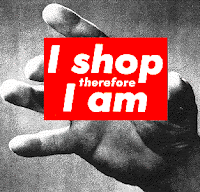Thursday 11 October 2012
Thursday 4 October 2012
The Flows of Globalisation and Consumerism
Globalisation can be defined in many ways but in a very basic description it is seen as 'individuals, groups and nations, becoming ever more interdependent on one another’ (Giddens, 2009: 126). The digital age and development of information and communication technologies have not only increased global communication, but the Internet in particular has ‘intensified the speed and scope of interaction between people all over the world’ (Giddens, 2009).
 |
| <source> |
This leading influence particularly relates to the ability to communicate and “create flows of not only of goods, services, money, and technology, but also of ideas, information, culture, people and power”, between various continents (Kuo and Fei, 2010). However there is also a downside to these flows and the president of Nabisco once defined the process as leading to “a world of homogeneous consumption” (Simmer-Brown, 2002), a process which benefits some countries but also creates obstacles for others. There are still many disadvantaged, poorer countries most of which will likely never benefit from the positive effects of Globalisation and in some instances are even exploited by it.
 |
| <sourc |
The Growth of Advertising and Consumerism
When the average Australian is exposed to around 3000 marketing messages and advertisements in a single day, it is easy to understand
how we have become this consumer society. Advertisers can ‘spend anywhere up to
$12 billion in a single year just to persuade us to buy stuff we never knew we
needed’ (evolve, 2012) which only increases our desire to consume.
 |
| <source> |
Between 1800 and 1930, around the time of modernity, invention and technology was on the rise and companies were making products faster than could be consumed. This shift is productivity lead to an increase in advertising and marketing strategies to get people to buy new products to replace the old ones - rather than repair them, like they had done previously. The increase in “technology was driving the output of goods, while marketing was creating the need for them – either actual or illusory”. This innovation and change in society has further generated a “culture of addiction”, one that utilises and even encourages an ‘unrestrained desire for personal and material satisfaction’ (Pérez and Esposito, 2010).
The bad side – E-waste and exploitation overseas
Although, this
attitude that exists in the throwaway society of today has much worse
consequences than having too much ‘stuff’. The increasing disposal of waste
puts Australians among
the highest users of new technology, and “waste from obsolete electronic merchandise,
e-waste, being one of the fastest growing types of waste in Australia” (ABS,2006).
In Europe the amount of electronic waste collected
annually is around six million tonnes, varying from computers, televisions,
phones and music devices to household appliance such as washing machines,
fridges and cookers. The decision to replace current
merchandise with newer versions is “happening more out of social compulsions
brought on by fads, such as changes in fashion or popularity’ rather than
genuine rationale” (Cunningham, 2007 as cited in Thomas and Wilson, 2012:46).
This short life span of products is also encouraging manufacturers to make products that are less durable and poorer quality, as they are intended to be thrown away after only a short period of use (Thomas and Wilson, 2012). The below video is fairly basic in explanation, but it makes the whole process very clear for those of you who may be unaware of our current consumerism system.
 |
| <source> |
This short life span of products is also encouraging manufacturers to make products that are less durable and poorer quality, as they are intended to be thrown away after only a short period of use (Thomas and Wilson, 2012). The below video is fairly basic in explanation, but it makes the whole process very clear for those of you who may be unaware of our current consumerism system.
One of the difficulties faced by consumers is that is that it is often cheaper (and easier) to buy new appliance, usually a better one, than to repair the old one. Recycling of such goods is also an issue as the complex parts that make up these appliances and devices take a lot of time and money to pull apart and dispose of properly (Geographical, 2005).
Therefore it is easier for consumers and large companies to dump the waste that is no longer needed however this also leads to concerns of where the dumping occurs. Schmidt (2006) points out that areas in African and Asian countries that have become “the world’s latest destination for obsolete electronic equipment”.
The worst part is that these developing countries where material is dumped often do not have access to such information technology due to the lack of requirements needed to manufacture it (Schmidt, 2006). Also many of the old appliances, computers and devices are in working order when they are dumped and are instead pulled apart by locals in order to sell in parts.
 |
| <source> |
 |
| <source> |
*Just a side note.. I found it ironic that as I was embedding YouTube videos in this blog, that they too have advertisements at the beginning of each video in an attempt to grab your attention and sell you products. These are sometimes related to what video you're watching, for example a new song you're listening to might have the ad for the artist's album featured at the beginning. However I've started to notice that often these ads are for things I know I've 'Googled' or stuff I'm actually interested in. I was unable to find any hard facts to back this up, but in the last few months, the content of these ads have been changing and I find myself clicking on more of them, or just simply choosing to watch, rather than skip them. Take a look next time you go to watch a video and pay attention to the type of ad it is for and whether it's something you actually would consider buying, liking, listening to or paying for.
This final video is about 'The Story of Electronics' and where they end up once we throw them away. This video is part of a bigger campaign called 'The Story of Stuff Project' that helps to educate consumers to make smarter choices about what and how they consume and how to make a difference to the current system.
References:
'a
waste-free world?', 2005, Geographical (Campion Interactive
Publishing), vol. 77, no. 9, p. 38.
ABS,
2006, Waste – ‘WASTE GENERATED PER PERSON’, Measures of Australia's
Progress, 2010 accessed October 1st, 2012 <source>
Barber,
BR 2008, 'Shrunken Sovereign Consumerism, Globalization, and American
Emptiness', World Affairs, vol. 170, no. 4, pp. 73-82.
Barnhart,
JK 1999, 'Teaching the Ugly Side of Consumerism', Technology Teacher,
vol. 59, no. 2, p. 27.
Cheng,
JY-s, Ngok, K-l & Huang, Y 2012, 'Multinational corporations, global civil
society and Chinese labour: Workers’ solidarity in China in the era of
globalization', Economic & Industrial Democracy, vol. 33, no. 3, pp.
379-401.
Evolve
network, 2012, ‘unclutter your mind’, august 24th,
online edition, accessed 27th September, 2012, <source>
Giddens,
A 2009, Sociology 6th ed, Polity Press, Cambridge, UK.
Kuo,
H & Fei, J 2010, 'Understanding Diaspora Cultures in the Context of
Globalization', International Journal of the Humanities, vol. 7, no. 10,
pp. 115-29.
Pérez,
F & Esposito, L 2010, 'The Global Addiction and Human Rights: Insatiable
Consumerism, Neoliberalism, and Harm Reduction', Perspectives on Global
Development & Technology, vol. 9, no. 1/2, pp. 84-100.
Schmidt,
C. W, 2006 ‘Unfair Trade e-Waste in Africa’, Environ Health Perspect,
114(4), pp: 232–235.
Shah,
A, 2011 ‘Consumption and Consumerism’ Global Issues website – Consumption
and Consumerism, <source>
Simmer-Brown,
J 2002, 'Remedying Globalization and Consumerism: Joining the Inner and Outer
Journeys in "Perfect Balance"', Buddhist-Christian Studies,
no. 22, p. 31.
Thomas,
SE & Wilson, PR 2012, 'Youth Consumerism and Consumption of Status
Products: A Study on the Prevalence of Social Pressure Among Students of
Professional Courses', IUP Journal of Business Strategy, vol. 9, no. 2,
pp. 44-64.
Subscribe to:
Posts (Atom)